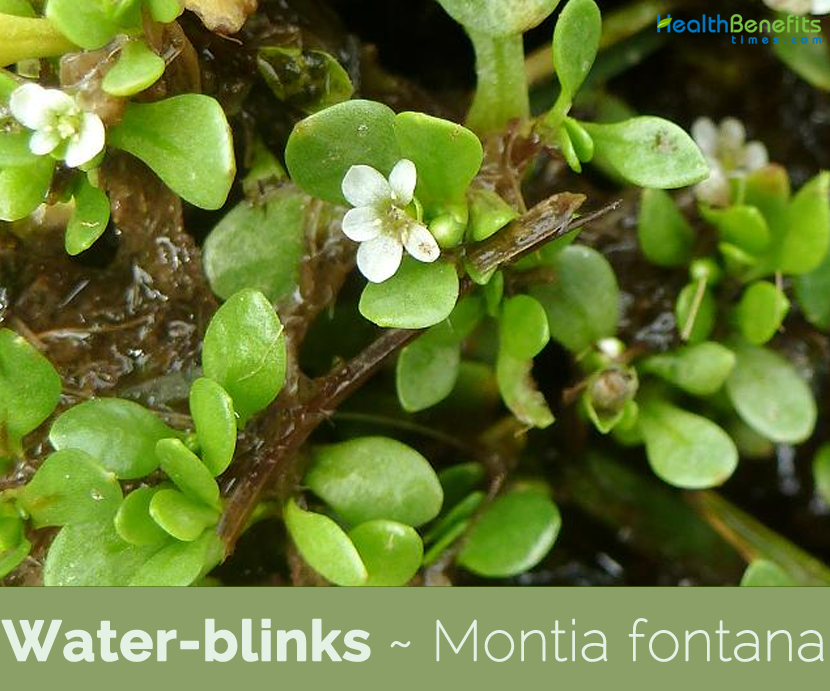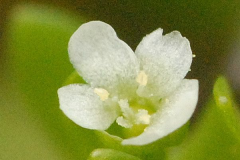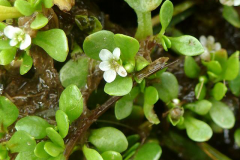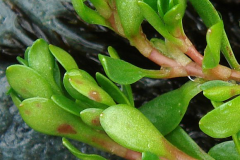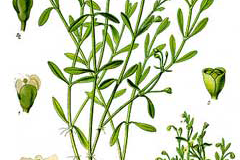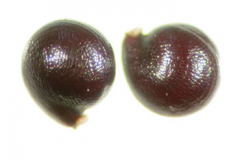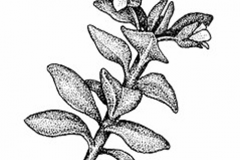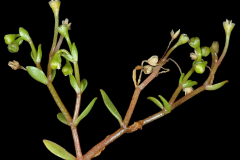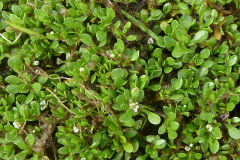Plant Description
Water blinks is an annual or perennial, glabrous and fleshy herb that may grows about 50 cm or more. The plant is found growing in springs, flushes, lake, river and stream margins, damp tracks, paths and winter-moist sand or gravel, wet meadows, around the margins of ponds, imperfectly drained moist areas, seepage slopes, moss, in wet springy places among mosses, along brooks, or among tall sedges and grasses by the edge of stagnant and muddy pools, less commonly in open places in wet sand or mud when stems become prostrate and somewhat tufted. The plant has taproot with fibrous roots from a lower stem nodes. Stem is thin and branching up to 50 cm or more when it grows in water and shorter when appears in land.
Leaves
Basal leaves are lacking; stem leaves are linear to broadly oblanceolate, opposite, 4-15 mm long, 1-7 mm wide, tapering to short stalks or unstalked.
Flowers
Flowers occur in solitary or in small umbellate clusters in upper axils, extremely short-lived; pedicels elongating to 1 cm long in fruit. Sepals wider than long, broadly rounded at apex, shortly united at base; petals are unequal, united in the lower third, white to pale mauve. Stamens 3; style trifid to below halfway to almost entire. Flowering normally takes place from May to October.
Fruits
Fertile flowers are followed by egg-shaped capsules, flattened, 1.5 mm long dehiscent by 3 valves usually with black, round seeds, 0.7-1.2 mm long, with numerous small projections, appendage round or flat.
- Very hot poultice of the plant fried in olive oil is applied over the bladder as a diuretic to treat difficulty urinating and pain caused by cystitis.
- Previously heated plant was placed on the affected area to treat suppurating sores and rheumatism.
Culinary Uses
- Leaves can be consumed raw.
- Fairly bland, Water-blinks are always eaten raw in salads after being meticulously cleaned.
- These salads are prepared dressing the plants with salt, vinegar and olive oil.
- Leaves can turn bitter in summer, mainly if the plant is growing in a hot dry position.
- Young and tender stems and leaves of this plant are traditionally consumed in the regions of the Iberian Peninsula where it grows.
- It is consumed even nowadays, being still possible to find it in some greengrocers and even in some restaurants.
References:
https://www.itis.gov/servlet/SingleRpt/SingleRpt?search_topic=TSN&search_value=20404#null
https://pfaf.org/User/Plant.aspx?LatinName=Montia+fontana
https://www.cabi.org/ISC/datasheet/115655
http://www.floracatalana.net/montia-fontana-l-
https://plants.usda.gov/core/profile?symbol=MOFO
http://www.theplantlist.org/tpl1.1/record/kew-2508965
https://en.wikipedia.org/wiki/Montia_fontana
https://gobotany.newenglandwild.org/species/montia/fontana/
http://www.herbiguide.com.au/Descriptions/hg_Waterblinks.htm
Comments
| Water-blinks Quick Facts | |
|---|---|
| Name: | Water-blinks |
| Scientific Name: | Montia fontana |
| Origin | California, also outside of California, but is limited to North America |
| Shapes | Globose capsule dehiscent by 3 valves and usually with 3 black, reticulated and reniform seeds |
| Calories | 36 Kcal./cup |
| Major nutrients | Manganese (46.52%) Vitamin C (32.11%) Vitamin E (30.00%) Iron (16.25%) Total dietary Fiber (11.68%) |
| Name | Water-blinks |
|---|---|
| Scientific Name | Montia fontana |
| Native | California, also outside of California, but is limited to North America |
| Common Names | Fountain miner’s lettuce, Annual water minerslettuce, Blinks, Water-blinks, Annual water miner’s-lettuce, Blinking chickweed, Fountain candyflower, Fountain miner’s-lettuce, Water chickweed, Dwarf montia |
| Name in Other Languages | Catalan: Amanida de gripau, Herba de les fonts, Herba dels gripaus, Herba Fontana, móntia, proljetna bunarka Czech: Zdrojovka hladkosemenná, zdrojovka prameništní, zdrojovka rolní Danish: Stor vandarve, vandarve Dutch: Klein bronkruid en groot bronkruid, Groot bronkruid, bronkruid, montia English: Fountain miner’s lettuce, Annual water minerslettuce, Blinks, Water-blinks, Annual water miner’s-lettuce, Blinking chickweed, Fountain candyflower, Fountain miner’s-lettuce, Water chickweed, Dwarf montia Estonia: Harilik allikrohi Finnish: Lähdehetekaali, hetekaali French: Montie des fontaines, Montie des sources, montia du printemps, montie des ruisseaux, mouron aquatique, mouron des fontaines, petit cresson German: Bach-Quellkraut, Quellkraut, Brunnenquellkraut, glattsamiges Quellkraut Greek: Móntia (μόντια) Hungarian: Forrásfű Icelandic: Lækjagrýta Italian: Centonchiello, pendolino delle fonti Irish: Fliodh uisce Latvian: Avotu montija Lithuanian: Saltininė menuva Norwegian: Kildeurt Polish: Zdrojek błyszczący Portuguese: Morujas, merujas, merujes, marujinha, meruginha Russian: montiya rodnikovaya (монтия родниковая), montsiya blestyashchesemyannaya (монция блестящесемянная), montsiya klyuchevaya (монция ключевая), montsiya rucheynaya (монция ручейная) Slovak: Zdrojovka prameništná Slovene: Navadni mokrič Spanish: Corujas, boru-jas, morujas, pamplinas, regajos, coca valenciana, comio, ensalata de sapo, hierba del manantial, mariquita, pamplina de agua Swedish: Källört, Källånke Turkish: Ege montiyası Welsh: Porpin y ffynnon |
| Plant Growth Habit | Annual or perennial, glabrous and fleshy herb |
| Growing Climates | Springs and flushes, lake, river and stream margins, damp tracks, paths and winter-moist sand or gravel, wet meadows, around the margins of ponds, imperfectly drained moist areas, seepage slopes |
| Plant Size | 50 cm or more |
| Root | Taproot with fibrous roots from lower stem nodes |
| Stem | Thin and branching stems up to 50 cm or more when it grows in water and shorter when appears in land |
| Leaf | Opposite, oblong, elliptic or spathulate, to 1 cm long, 4 mm wide, the bases expanded and very shortly fused around the stem |
| Flowering season | May to October |
| Flower | Solitary or in small umbellate clusters in upper axils, exceedingly short-lived; pedicels elongating to c. 1 cm long in fruit; sepals wider than long, broadly rounded at apex, shortly united at base |
| Fruit Shape & Size | Globose capsule dehiscent by 3 valves and usually with 3 black, reticulated and reniform seeds |
| Seed | Black, almost globular with concentric rows of tiny warts |
| Propagation | By seed |
| Season | June to October |
| Major Nutrition | Manganese, Mn 1.07 mg (46.52%) Vitamin C (Ascorbic acid) 28.9 mg (32.11%) Vitamin E (alpha-tocopherol) 4.5 mg (30.00%) Iron, Fe 1.3 mg (16.25%) Total dietary Fiber 4.44 g (11.68%) Vitamin B9 (Folate) 41.8 µg (10.45%) Potassium, K 385 mg (8.19%) Magnesium, Mg 31.7 mg (7.55%) Sodium, Na 90.7 mg (6.05%) Copper, Cu 0.05 mg (5.56%) |


